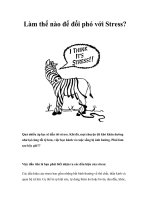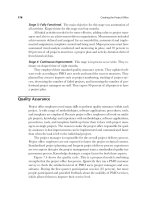Tài liệu Confronting the Region docx
Bạn đang xem bản rút gọn của tài liệu. Xem và tải ngay bản đầy đủ của tài liệu tại đây (1.21 MB, 72 trang )
Confronting the Region:
A Profile of Southern Africa
Sanusha Naidu and Benjamin Roberts
HSRC
Publishers
Free download from www.hsrc
p
ress.ac.za
Integrated Rural and Regional Development Research Programme, Occasional Paper 8
Series Editor: Mike de Klerk, Executive Director: Integrated Rural and Regional Development
Research Programme, Human Sciences Research Council
Published by HSRC Publishers
Private Bag X9182, Cape Town, 8000, South Africa
www.hsrcpublishers.ac.za
© 2004 Human Sciences Research Council
First published 2004
All rights reserved. No part of this book may be reprinted or reproduced or utilised in any form
or by any electronic, mechanical, or other means, including photocopying and recording, or in
any information storage or retrieval system, without permission in writing from the publishers.
ISSN 1684-5250
ISBN 0 7969 2060 5
Cover by Jenny Young
Production by comPress
Distributed in Africa by Blue Weaver Marketing and Distribution,
PO Box 30370, Tokai, Cape Town, 7966, South Africa.
Tel: +27 +21-701-4477
Fax: +27 +21-701-7302
email:
Distributed worldwide, except Africa, by Independent Publishers Group,
814 North Franklin Street, Chicago, IL 60610, USA.
www.ipgbook.com
To order, call toll-free: 1-800-888-4741
All other inquiries, Tel: +1 +312-337-0747
Fax: +1 +312-337-5985
email:
Free download from www.hsrc
p
ress.ac.za
Preface
The Integrated Rural and Regional Development Research
Programme of the Human Sciences Research Council
publishes an Occasional Paper series which is designed to
offer timely contributions to debates, disseminate research
findings and otherwise engage with the broader research
community. Authors invite comments and responses from
readers.
Free download from www.hsrc
p
ress.ac.za
About the Authors
Sanusha Naidu is a research specialist in the Integrated Rural
and Regional Development Research Programme and the
Southern African Regional Network (SARPN). After completing
a BA law degree and an Honours degree in political science at
the University of Durban-Westville, she obtained an MA in
International Relations from Staffordshire University, England.
Prior to joining the HSRC, Sanusha was Senior Africa
researcher at the South African Institute of International
Affairs. She has published in the areas of African political
economy and democratisation. At present she is co-leading a
project that tracks South African corporate expansion into
Africa. She can be contacted at
Benjamin Roberts is a research specialist in the Integrated
Rural and Regional Development Research Programme and
the Southern African Regional Poverty Network (SARPN). He
has a BSc degree in town and regional planning (cum laude)
from the University of the Witwatersrand and an MSc degree
in urban and regional planning (development)(cum laude)
from the University of Natal. Prior to joining the HSRC, he was
research fellow in the Population and Poverty Studies
Programme at the School of Development Studies at the
University of Natal.
Benjamin has extensive experience in the micro-econometric
analysis of household surveys. His journal publications deal
mainly with issues of poverty measurement, especially from a
longitudinal perspective. He can be contacted at broberts@
hsrc.ac.za.
Free download from www.hsrc
p
ress.ac.za
V
Confronting the Region: A Profile of Southern Africa
Contents
Introduction 1
Political Context 4
Economic Context 10
Economic activity and development 10
Trade and investment patterns in SADC 11
Labour trends and unemployment patterns 15
Public sector expenditure 17
Trends in human development 19
Challenges to Social Development 28
Food security 28
HIV/AIDS pandemic 30
The State of the Environment in Southern Africa 33
Biological resources 33
Climate 34
Coastal and marine resources 35
Urbanisation 35
Forests and woodlands 37
Fresh water 38
Land 38
Regional Integration in Southern Africa 39
Progress toward regional integration 43
Challenges to regional integration in southern Africa 46
Free download from www.hsrc
p
ress.ac.za
VI
Sanusha Naidu and Benjamin Roberts
Regional Infrastructure 49
‘Peace Parks’ 52
Transport 54
Communications 55
Conclusion 57
Notes 59
References 60
Free download from www.hsrc
p
ress.ac.za
VII
Confronting the Region: A Profile of Southern Africa
Acronyms
AISA Africa Institute of South Africa
AMCEN African Ministerial Conference on the Environment
CBI Cross Border Initiative
COMESA Common Market for Eastern and Southern Africa
DRC Democratic Republic of Congo
EAC East African Community
ECOWAS Economic Community of West African States
FANR Food, Agriculture and Natural Resources
FAO Food and Agriculture Organization of the United
Nations
FSI Foreign Direct Investment
FTA Free Trade Agreement
GDP Gross Domestic Product
GER Gross Enrolment Ratios
HDI Human Development Index
HPI Human Poverty Index
HSRC Human Sciences Research Council
ICE Intergovernmental Committee of Experts
ITU International Telecommunication Union
NEPAD New Partnership for Africa’s Development
NGOs Non-governmental Organisations
ODA Official Development Assistance
OPDS Organ on Politics, Defence and Security
REC Regional Economic Community
RIAs regional Integration Arrangements
RIFF Regional Integration Facilitation Forum
RISDP Regional Indicative Strategic Development Plan
SACU Southern African Customs Union
SADC Southern African Development Community
Free download from www.hsrc
p
ress.ac.za
VIII
Sanusha Naidu and Benjamin Roberts
SAIIA South African Institute of International Affairs
SAPES Southern African Political Economy Series
SAPP Southern African Power Pool
SATA Southern African Telecommunications Association
SDIs Spatial Development Initiatives
TFCA Transfrontier Conservation Area
TRASA Telecommunications Regulators Association of
Southern Africa
UNAIDS United Nations Programme on HIV/AIDS
UNCCD United Nations Convention to Combat
Desertification
UNDP United Nations Development Programme
UNECA United Nations Economic Commission for Africa
UNEP United Nations Environment Programme
UNFCCC United Nations Framework Convention on
Climate Change
WSSD World Summit on Sustainable Development
Free download from www.hsrc
p
ress.ac.za
Confronting the Region:
A Profile of Southern Africa
Introduction
The southern African region is made up of all countries south
of and including Tanzania and the Democratic Republic of
Congo (DRC). It is a plateau region edged by many escarp-
ments, cliffs or steep slopes. The region comprises 14 countries
and spans a geographical area the size of the continental
United States.
1
It has a population of approximately 200 million
people, with most of the inhabitants concentrated in the
region’s cities and large urban centres. The rural dwellers
remain dispersed.
Climatic conditions vary in the region, and topographical
features range from savanna grasslands to deserts. The eastern
parts of the region have more moisture owing to the influence
of currents in the Indian Ocean. While Mozambique on the
east coast experiences an average annual rainfall of between
30 and 56 inches, countries such as Namibia in the west have
arid conditions with an average annual rainfall of between
four and 12 inches. Such conditions make the region
vulnerable to erratic climatic patterns of droughts and floods.
In recent years, the region has witnessed increased political,
economic and social engagements. After several decades of
political and military confrontation and unrest, accompanied
1
Free download from www.hsrc
p
ress.ac.za
Sanusha Naidu and Benjamin Roberts
2
by economic decline and social instability, the region is now
experiencing a degree of political stability with increased
prospects of economic recovery. The cessation of hostilities in
Angola, the signing of a peace agreement in the DRC and the
peaceful elections in Lesotho in 2002 herald possibilities for
greater integration and cooperation in the region. From an
economic perspective, and despite the imbalances amongst
states and the relatively small market size, the region has an
aggregate gross domestic product (GDP) of US$226,1 billion.
This is more than double that of the Economic Community of
West African States (ECOWAS), and equivalent to more than
half the aggregate GDP of sub-Saharan Africa. The latter bodes
Figure 1:The SADC region
Source: />Free download from www.hsrc
p
ress.ac.za
well for the proposed Free Trade Agreement (FTA), which
should be formalised by 2008.
Yet, in spite of the progress made on the ground, the region
is not without its challenges. While countries in the region may
share a common vision of rapid economic and political
progress, and a commitment to a common development path,
the region is beset with crises that undermine sustainable
development and overall efforts towards regional integration.
Politically, the peace dividends obtained, especially in the DRC
and Angola, have been offset by the ongoing political and
economic crises in Zimbabwe, and by the lack of basic political
and democratic freedom in Swaziland. More importantly,
democracy in the region is still too young and fragile for many
countries to claim sufficient experience in democratic consoli-
dation. Economically and socially, the region is still far from
overcoming the imploding humanitarian disaster of HIV/AIDS.
The HIV/AIDS pandemic, together with other health problems
such as tuberculosis, malaria and cholera, has placed countries
at risk of increased mortality rates, a skewed demographic
profile, a growing number of orphaned and vulnerable children,
and the internal displacement of people. The latter problem has
been compounded by a food security crisis. In effect, the
region’s poverty seems to be deepening as a result of widening
inequality; weak political, social and economic governance
structures; and a burgeoning crisis in health.
Despite these composite problems, countries in the region
are moving towards consolidating regional integration and
cooperation under the Regional Indicative Strategic Develop-
ment Plan (RISDP). Approved in 2003, the RISDP is designed to
provide Southern African Development Community (SADC)
member states, their institutions and policy makers with a
coherent and comprehensive development agenda (based on
strategic priorities) for social, political and economic policies
over the next 15 years. However, implementation of the RISDP
will not be without its challenges. Regional identity will remain
a core problem. While SADC member states have committed
Confronting the Region: A Profile of Southern Africa
3
Free download from www.hsrc
p
ress.ac.za
themselves to the task of regional cooperation, regional identity
amongst them is still remote. Attachment to national identity
and sovereignty dominates the focus of the summit agendas,
and the reluctance to hold errant and despotic leaders
accountable is evidently based on a sense of fraternity. How-
ever, it may be that this reluctance is actually part of a policy of
constructive engagement or quiet diplomacy. On the ground,
indications are that SADC is still far from being consolidated as
a regional bloc with a common agenda. Moreover, it is being
hamstrung by the majority of the states’ overlapping member-
ships of other regional integration networks such as the
Common Market for Eastern and Southern Africa (COMESA)
and the East African Community (EAC).
The region thus represents a matrix of competing interests
and contending difficulties. Nonetheless, it is one of the more
robust regions on the continent, with increased movement
toward a free trade area and democratic practice. Many donors
and nongovernmental organisations (NGOs) alike estimate
that southern Africa’s reasonably well-developed infrastructure
and diverse natural resource base have the potential to lead
the rest of Africa towards a more prosperous 21st century.
The core focus of this profile is to provide an understanding
of the main developmental and institutional challenges that
confront the region by:
• Analysing its political, economic and social contexts, and
identifying common trends;
• Reviewing progress made in the promotion of greater
regional integration; and
•Investigating the extent to which member states adopt a
regional identity.
Political Context
The political situation in the region is characterised by a
diversity of political systems and varying levels of political
stability. These systems range from a traditional and increas-
Sanusha Naidu and Benjamin Roberts
4
Free download from www.hsrc
p
ress.ac.za
Confronting the Region: A Profile of Southern Africa
5
ingly authoritarian monarchy to constitutional democracies.
There are also no-party and one-party dictatorships, and
democratic systems with more widespread participation by
civil society and media independence. Democracies of the
region are young and fragile, with many countries located
between a stage of democratic nation building and institu-
tional reform but prone to occasional constitutional setbacks
and clampdowns on freedom of speech (Southall 2003).
As Table 1 suggests, the past few years have produced some
movement towards the building of democracy in most of the
region. This is reflected in developments such as the holding
of free and fair elections in a number of countries, the general
acceptance of election results between political parties,
notably in Lesotho, and increased respect for national
constitutions so that heads of state are prevented from
entrenching themselves in power. However, several factors
militate against these developments, notably:
• The deteriorating political and economic conditions in
Zimbabwe, affecting, in particular, Botswana and South
Africa;
• The increased centralisation of executive power in
Namibia;
• The mounting levels of repression in Swaziland and the
increasingly lawless nature of the rule by monarchy;
• The ongoing regionalisation of the DRC conflict, which is
producing destabilisation and internecine conflict in the
sub-continent.
Alongside these concerns is the issue of human security or the
creation of an environment necessary for the furtherance of
human development. Food security
2
, for example, is funda-
mental to the development and maintenance of human
security. Acute food shortages in many parts of the region, as
well as fairly large-scale levels of internal migration, are
placing a strain on the region’s natural resource base. This is
compounded by periodic climate shocks in the form of
drought and flooding. In several countries of the region, food
Free download from www.hsrc
p
ress.ac.za
Sanusha Naidu and Benjamin Roberts
6
shortages have led to hunger and poverty, and a burgeoning
informal market. These problems already play a major part in
regional relationships and they will intensify as the AIDS crisis
worsens.
A further significant and persistent threat to regional security
is the abundance of cheap and easily accessible small arms
and semi-automatic weaponry. In large part, this is the legacy
of decades of civil war in the region. In Mozambique, for
example, up to six million arms were imported during the civil
war. After the 1992 peace accord, a UN peacekeeping mission
collected some 190 000 weapons, but most of these found
their way back onto the streets or were ‘exported’ to
neighbouring states. A similar situation is likely to unfold in
Angola and the DRC during the arms demobilisation phase.
These concerns have brought to the fore worries about the
level of political democracy in the region. With many countries
in the region only now beginning to adopt democratic practice
as a yardstick of good governance, southern Africa has a long
way to go before democratic consolidation can be attained.
But the signs are encouraging. Political elites increasingly
recognise the link between development and democracy, and
seem more committed than ever to address conflicts, end
hostilities and abide by the rules of democratic practice.
Another positive development is the attempt to address
corrupt practices in the region. In spite of a number of
countries in the region being poorly ranked in terms of
Transparency International’s Corruption Perceptions Index,
the adoption of an anticorruption protocol by the heads of
state and governments of the Southern African Development
Community (SADC) in August 2001 represents a progressive
commitment to redressing the situation. The protocol, adopted
at the Malawi summit, focuses on a range of preventive
measures, which include codes of conduct, access to
information and protection for informants. Moreover, it
requires governments to criminalise the bribery of foreign civil
servants, thereby making corruption an extraditable offence
(Lodge 2003).
Free download from www.hsrc
p
ress.ac.za
Confronting the Region: A Profile of Southern Africa
7
Table 1: A general survey of the state of democracy in the region
Country Political status Threats to
democracy
Angola
Botswana
DRC
Lesotho
1. Demobilising
soldiers.
2. Internal
displacees and
returning
refugees.
3. High levels of
corruption.
4. Weak civil society
structures.
5. Controlled
media.
1. HIV/AIDS levels.
2. Refugee inflow
from Zimbabwe.
1. Ethnic cleansing
and faction
fighting.
2. Weak political
institutions.
3. Lack of media
independence.
4. No civil society
structures.
1. Excessive
dependence on
exports to the US
market (AGOA).
1994 peace accord shattered.
Renewed political and civil strife.
Death in 2002 of Unita leader,
Jonas Savimbi, produced a
ceasefire agreement and a
rapprochement between UNITA
and MPLA.
Single-party dominance by
Botswana Democratic Party since
independence in 1967 reflects
both its (Botswana Democratic
Party (BDP)) good governance
record and the ethnic dominance
of the Bamangwato people.
Peace agreement in 2003
facilitating democratisation
process. Prospects of stability and
peace fragile as a result of
continued hostilities and armed
resistance to the peace process
between government forces,
various factions and rebel groups.
Legitimate election held in 2002
following disputed 1998 election,
which generated an attempted
coup d’état.Vigorous attempts
presently being made to combat
corruption and consolidate
nation building.
Free download from www.hsrc
p
ress.ac.za
Sanusha Naidu and Benjamin Roberts
8
Table 1 cont.
Country Political status Threats to
democracy
Malawi
Mozambique
2. Economy reliant
on migrant
remittances.
1. Levels of poverty
exacerbated by
severe drought
and famine.
1. High levels of
corruption.
2. Tensions
between
Renamo-
controlled
provinces and
central govern-
ment over
delegation of
powers.
3. Independence of
political and
institutional
structures such
as the judiciary
compromised by
influence from
Frelimo.
4. Asymmetrical
levels of
development
between regions.
Signs of political maturity with
sustained opposition forcing
President Maluzi to abandon
attempt to change constitution
to enable him to stand for a third
term in 2004 election.
General peace agreement
reached in 1992. Multiparty
elections in 1994 and 1999 but
Renamo claimed it was denied
victory in 1999 poll. President
Chissano has announced he will
not seek a third term in 2004.
Free download from www.hsrc
p
ress.ac.za
Confronting the Region: A Profile of Southern Africa
9
Table 1 cont.
Country Political status Threats to
democracy
Namibia
South Africa
Swaziland
Tanzania
Zambia
1. Weak opposition.
2. Centralising
tendency within
Swapo and
increasing
hostility to
dissent.
1. Weak opposition
and single-party
domination with
tendency to
centralisation.
2. Extreme levels of
socioeconomic
inequality.
1. Extreme levels of
poverty.
2. Collapse of
independent
judiciary.
3. Curbs on media
expression.
1. Separatist
movement in
island of
Zanzibar.
1. High levels of
poverty and
unemployment.
2. Weak economy
and excessive
dependency on
global terms of
trade.
Formal independence since 1990.
Increasing centralisation of power
in presidency. Nujoma has
changed constitution once to
stand for third term. Conflict over
the Caprivi strip, bordering
Botswana, threatens to spill over
into the region.
Democracy since 1994.
Entrenchment of democratic
procedures. Stable.
Least democratic state in region.
Ruled by authoritarian monarchy
with increasingly despotic
tendencies.
Mature, functioning democracy.
Successful election in 2000.
Stable multiparty system.
Attempt by President Chiluba to
change constitution to enable
him to seek third term resisted.
2002 election resulted in stable
transition. Attempts to address
corruption.
Free download from www.hsrc
p
ress.ac.za
Sanusha Naidu and Benjamin Roberts
10
Economic Context
Economic activity and development Despite the relatively
small size of the southern African market, the SADC’s gross
domestic product of US$226.1 billion in 2001 is more than
double that of the Economic Community of West African States
(ECOWAS) and more than half of sub-Saharan Africa’s
aggregate GDP. Even so, the regional economy continues to
reflect a strong dependence on the primary sectors of
production, specifically the exporting of agricultural and
mining commodities. These account for on average more than
half of the GDP (Kritzinger-van Niekerk & Pinto Moreira 2002).
With uneven levels of socioeconomic development and the
exigency of addressing the pervasive poverty afflicting the
region, many member states embarked upon IMF/World Bank-
directed stabilisation and adjustment programmes in the early
1990s. The aim of these programmes was to promote macro-
economic stability and higher growth alongside improved
social service provision (SADC FANR 2003).
While most SADC countries recorded high-growth
performance during the 1970s, economic growth in the region
slowed down in the 1980s, partly because of deteriorating
terms of trade and policy failures. As Table 3 illustrates, a
degree of recovery occurred in the 1990s, albeit unevenly.
Table 1 cont.
Zimbabwe
1. Famine and
starvation.
2. High levels of
violent repres-
sion, especially
in rural areas
and opposition
strongholds.
Collapse of democracy and rule
of law. Steady degeneration to
fascism. Independence of
judiciary destroyed. Dissident
media crushed.
Source: EISA () and World Bank ( />Country Political status Threats to
democracy
Free download from www.hsrc
p
ress.ac.za
Some of the factors underpinning the recovery were an
increase in foreign direct investment, particularly in Angola,
South Africa, Mozambique and Botswana; positive political
developments; and the introduction of macroeconomic
reforms. These have generally served to improve tax collec-
tion, liberalise exchange controls, bring inflation under control
and reduce budget deficits. However, in spite of this progress,
Angola, the DRC, Malawi, Mozambique, Tanzania and Zambia
remain severely indebted, while Zimbabwe is considered
moderately indebted. This debt burden has made many SADC
states dependent on official development assistance (ODA) to
maintain prudent macroeconomic policies while simultaneous-
ly attempting to meet commitments to poverty reduction
through public expenditure.
Trade and investment patterns in SADC With regard to trade
liberalisation, most economies within the SADC region are
either moderately or fully open, with foreign trade playing a
Confronting the Region: A Profile of Southern Africa
11
Country Score Rank
Angola 1.7 98
Botswana 6.4 24
DR Congo
Lesotho
Malawi 2.9 68
Mozambique
Namibia 5.7 28
South Africa 4.8 36
Swaziland
Tanzania 2.7 71
Zambia 2.6 80
Zimbabwe 2.7 71
Table 2: Corruption Perceptions Index,2002
Source: Lambsdorff (2003)
Note: In terms of the score values, 10 is ’ highly clean’ and 0 is ‘highly corrupt’. As for rank,
102 countries were surveyed,where 1 = least corrupt and 102 = most corrupt.The symbol,
‘ ’ indicates that no data is available for that country.
Free download from www.hsrc
p
ress.ac.za
Sanusha Naidu and Benjamin Roberts
12
salient role for many. Though trade within SADC has
intensified since the early 1990s, intraregional trade generally
remains low. The share of intraregional imports amounted to
12 per cent of total imports in 1999, while intraregional
exports comprised less than nine per cent of total exports.
Trade appears to be a more significant contributor to GDP
in the smaller regional economies (e.g. Lesotho and
Swaziland) than in the larger ones. South Africa predominates
in intraregional trade and accounts for more than 70 per cent
of the imports of other countries in the region. Irrespective of
the low levels of intraregional trade, trade flows increased
noticeably during the past decade, with the share of
intraregional exports relative to total exports more than
doubling between 1990-1999, as shown in Figure 2
(Kritzinger-van Niekerk & Pinto Moreira 2002; SADC FANR
2003).
Average annual real growth rate (%)
Country 1980–1990 1991–2000
Angola 1.5 -0.3
Botswana 10.5 5.5
DRC 1.1 -6.0
Lesotho 4.0 3.8
Malawi 2.0 3.8
Mozambique -1.8 5.9
Namibia 0.8 4.5
South Africa 1.9 1.5
Swaziland 6.2 2.9
Tanzania 3.4 2.6
Zambia 1.3 0.2
Zimbabwe 5.4 3.0
Africa 2.5 2.3
Table 3: Average annual real GDP growth rates in the SADC region,
1980–2000
Source: Pillay (2002)
Free download from www.hsrc
p
ress.ac.za
Approximately 80 per cent of to Foreign Direct Investment
(FDI) to developing countries is directed to East Asian and
Latin American regions, a share that remained fairly constant
during the 1990s. By contrast, sub-Saharan Africa has tended
to be marginalised, receiving a mere three to five per cent of
total developing country FDI over the period. For SADC
countries, the estimated share of total FDI fluctuated between
two to three per cent between 1995 and 1999. The experience
of SADC countries in attracting long-term capital flows has
been varied. Although, in US dollar terms, the FDI received by
SADC countries is generally small, the small size of many of
these economies means that, in actuality, these inflows as a
percentage of GDP have been high relative to other develop-
ing economies. These inflows are often explained by a
relatively small number of large transactions and tend to occur
in countries where there are unexploited natural resources.
As Table 4 shows, direct investment inflows into the SADC
region were in the latter 1990s directed at Angola and South
Africa. In Angola, FDI was mainly into the oil and natural gas
Confronting the Region: A Profile of Southern Africa
13
Figure 2: Intra-SADC trade (% of total exports)
Source: AISA and HSRC (2003)
Free download from www.hsrc
p
ress.ac.za
sectors, whereas South Africa attracted foreign investment
across a broad number of sectors. South Africa is the dominant
investment destination in the region as it offers a considerably
larger market than neighbouring countries (accounting for
more than 70 per cent of SADC’s total GDP) and a more
developed business infrastructure. It is, however, important to
note that despite the relative regional significance, these FDI
inflows into South Africa constitute a minute share of the
country’s GDP (rarely exceeding one per cent).
Sanusha Naidu and Benjamin Roberts
14
Country 1997 1998 1999 2000 2001
SADC 5 530 3 320 5 304 2 956 8 805
Angola 412 1 114 2 471 879 1 119
Botswana 100 96 37 57 56
DRC 1 1 1 23 32
Lesotho 269 262 136 119 118
Malawi 22 70 60 45 58
Mozambique 64 213 382 139 255
Namibia 84 77 111 153 99
South Africa 3 817 561 1 502 888 6 653
Swaziland -48 165 90 -18 69
Tanzania 158 172 183 193 224
Zambia 207 198 163 122 72
Zimbabwe 135 444 59 23 5
Source: AISA and HSRC (2003)
Table 4: Foreign direct investment: net inflows, in US$ millions (nominal)
The relatively high levels of investment in Mozambique and
Lesotho in the late 1990s were partially the result of mega-
infrastructure projects such as the Mozal aluminum smelter
and Maputo Corridor in Mozambique, and the Lesotho
Highlands water project. Economic reform and the privati-
sation of state-owned enterprises has been another important
source of FDI in SADC, although this has been politically and
administratively difficult for most countries to implement.
Inflows of direct investment through this means have occurred
Free download from www.hsrc
p
ress.ac.za
in Mozambique, Zambia, Tanzania, South Africa and Lesotho.
For a country such as Botswana, which has not had a large-
scale privatisation programme and few mega-infrastructure
projects over the past decade, FDI has tended to be relatively
low. Similarly, countries beset with political uncertainty and
economic instability, such as Zimbabwe, are unlikely to attract
substantial new inflows of foreign capital in the near future
(Jenkins & Thomas 2002).
Labour trends and unemployment patterns From available
empirical evidence, the rate of formal sector wage employ-
ment within the region is low and below the average rate of
growth of the labour force. This jobless growth has been
ascribed to factors such as the low absorptive capacity of
energy, transport, communications and certain industrial
activities, and declining employment in the South African coal
and gold mines (SADC FANR 2000). This slow growth of
Confronting the Region: A Profile of Southern Africa
15
Source: Pillay (2002)
Note: The symbol ‘ ’ indicates that no data is available for that country.
Country Agriculture Industry Services
1980 1996 1980 1996 1980 1996
Angola 74 68 10 11 17 21
Botswana 70 42 13 41 17 17
DRC 71 60 13 17 16 23
Lesotho 86 81 4 6 10 13
Malawi 83 70 7 17 9 13
Mozambique 84 81 7 10 8 9
Namibia 43 40 22 37 36 23
South Africa 17 35 48
Swaziland 74 64 9 13 17 23
Tanzania 86 79 5 7 10 14
Zambia 73 68 10 12 17 20
Zimbabwe 73 66 10 14 17 20
Africa 70 62 11 15 19 23
Table 5: Labour force by sector (percentage in)
Free download from www.hsrc
p
ress.ac.za
formal sector employment has meant that new labour market
entrants have had to be absorbed into agriculture or informal
sector activities. Table 5 shows the distribution of the labour
force by sector for each of the SADC member states between
1980 and 1996. It clearly points to the pre-eminence of the
agricultural sector as a source of employment for most SADC
countries over the period, with Botswana, Namibia and South
Africa being the main exceptions.
In Table 6, country-level indicators of labour force
participation are provided for the 1980–99 period. A declining
participation rate can be observed in Angola, the DRC,
Lesotho, Malawi, Mozambique and Namibia. In Swaziland,
Tanzania and Zambia the rates remained virtually unchanged.
Improvements were observed only in Botswana, South Africa
and Zimbabwe, though the gains in the latter will have
reversed latterly. The table also provides gender-disaggregated
statistics. The gender inequalities evident in the regional
Sanusha Naidu and Benjamin Roberts
16
Country Total Female Male
1980 1999 1980 1999 1980 1999
Angola 49.5 45.9 45.7 42 53.3 49.9
Botswana 43.6 44.0 41.8 39.4 45.5 48.8
DRC 44.4 41.1 38.8 35.4 50.4 47.0
Lesotho 42.0 41.8 30.9 30.5 53.8 53.6
Malawi 50.3 47.6 49.3 46.0 51.4 49.3
Mozambique 55.3 51.8 53.3 49.5 57.3 54.1
Namibia 43.3 41.3 34.4 33.5 52.7 49.0
South Africa 38.3 40.9 26.8 30.7 50.0 51.5
Swaziland 35.7 35.7 23.5 25.8 48.0 46.2
Tanzania 51.2 51.1 50.2 49.9 52.2 52.4
Zambia 41.8 41.8 37.2 37.1 46.7 46.5
Zimbabwe 44.9 47.8 39.5 42.2 50.4 53.6
Africa 42.9 43.3 34.2 35 51.7 51.6
Table 6: Labour force participation rate (percentage of population of all
ages in labour force)
Source: Pillay (2002)
Free download from www.hsrc
p
ress.ac.za
labour market in 1980 have persisted over time, which suggests
that gender concerns have not been adequately mainstreamed
into policy formulation and programme implementation. In
South Africa, labour force participation increased more for
women (3.9 per cent) than for men (1.5 per cent), while in
Swaziland female participation increased 2.3 per cent and male
participation actually fell by 1.8 per cent.
Unemployment rates within the SADC region are high and
show a firm upward trend, with estimates increasing markedly
from 18.6 million in 1986 to 50.9 million in 2000, or from 31 to
59 per cent. From a sectoral perspective, it is estimated that
employment in the subregion declined by 16.2 per cent
between 1986 and 1998, with the decline of 18.7 per cent in
the agricultural sector exceeding that in the industrial sector,
while the decline in the services sector was only 6.6 per cent.
Employment in the agricultural sector dipped significantly after
1992, when a severe drought hit the SADC area, stabilising
only four or five years later (Kritzinger-van Niekerk & Pinto
Moreira 2002).
Public sector expenditure Those governments in the region
recording a decrease in debt service as a percentage of GDP
between 1990 and 2000 (Botswana, Malawi, Mozambique,
Swaziland and Tanzania) have not consistently used their debt
savings to increase social spending, such as in the education
or health sectors. Botswana and Malawi are the two SADC
countries that show a clear negative association (as one goes
down the other goes up) between debt service and social
spending in these sectors, with a corresponding positive
relationship (both exhibiting trends in the same direction, e.g.
both declining) between debt service and military expendi-
ture. In the case of Mozambique, declining debt service did
not translate into gains in education even with a sizeable
decrease in military spending. In the case of Swaziland, there
was a nominal increase in education expenditure and a
moderate gain in health spending. However, the military vote
also showed a nominal increase. Finally, in Tanzania, there
Confronting the Region: A Profile of Southern Africa
17
Free download from www.hsrc
p
ress.ac.za









